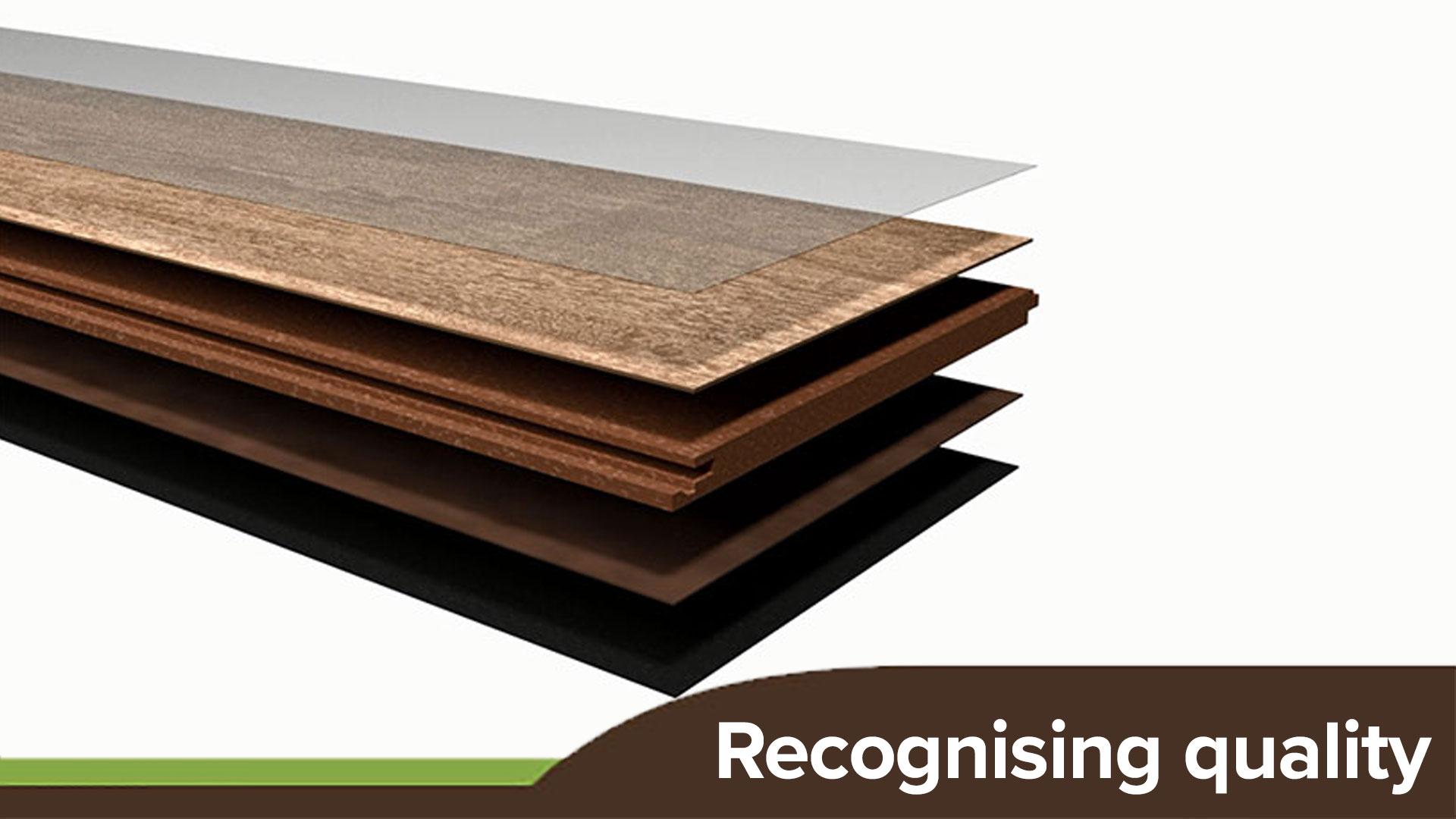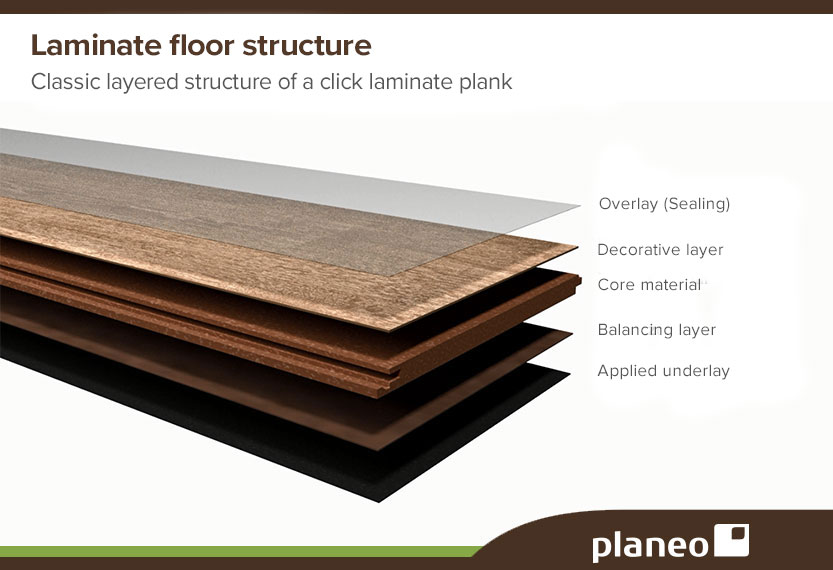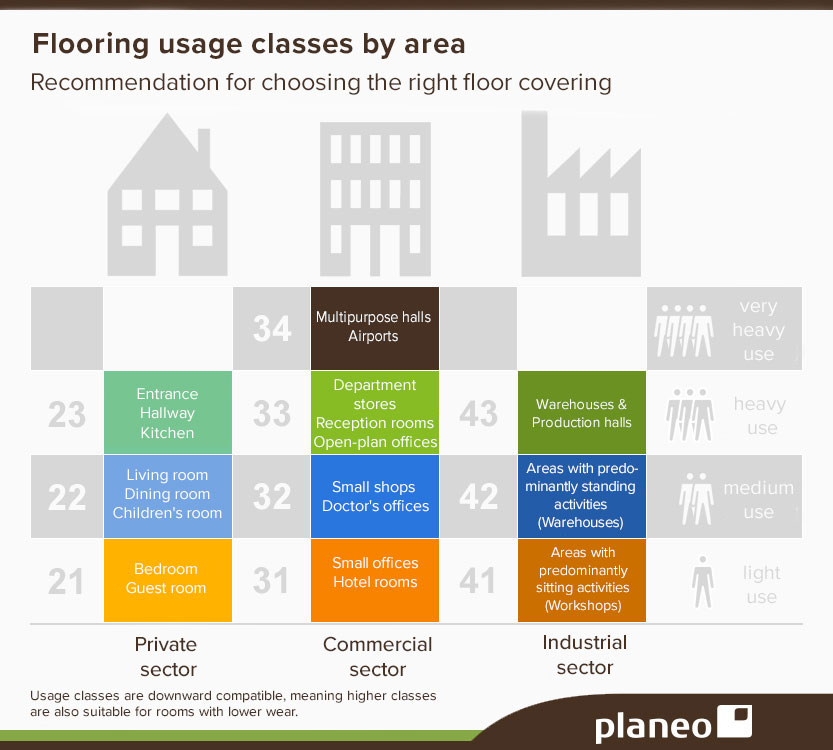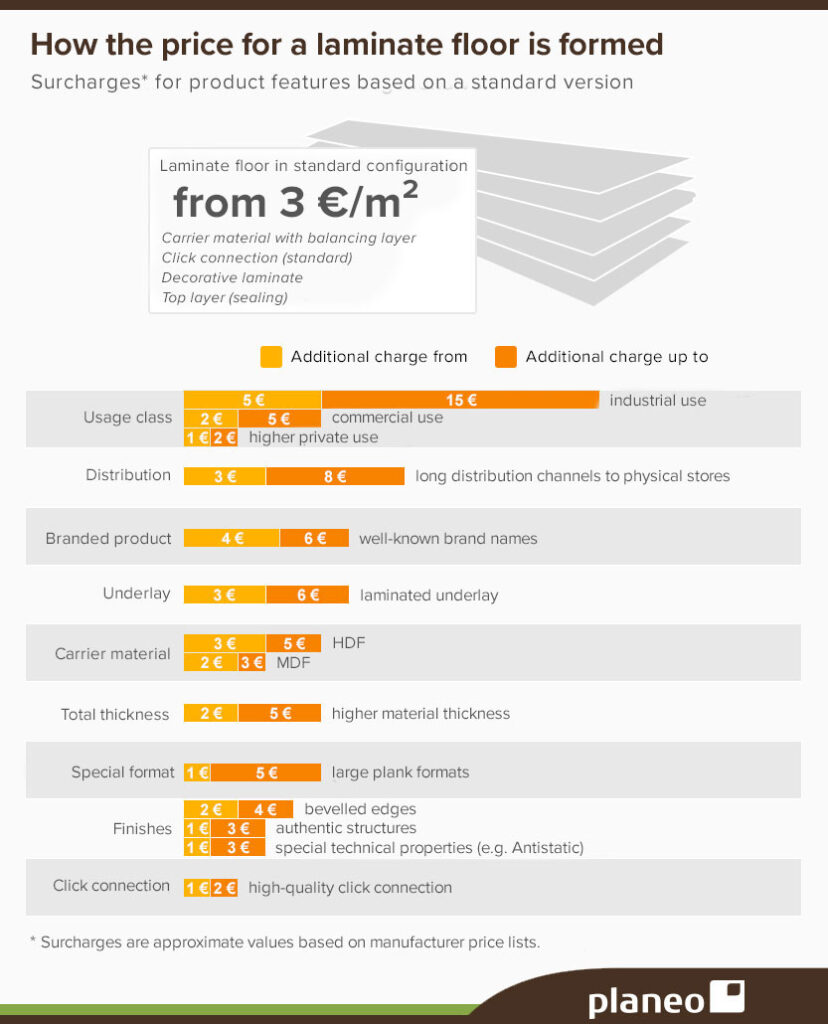
Laminate flooring is the ideal choice when it comes to functionality, variety of designs, and durability. As an alternative to more complex and often costly hardwood flooring, laminate flooring, with its balanced price-performance ratio, ranks high among popular floor coverings. We take an in-depth look at the properties and advantages of laminate. In addition, we explain how to assess differences in price and quality. Laminate is suitable for both residential and commercial use, with options available across different usage classes.
Content
- 1 Advanced Product System - Detailed Structure
- 2 Key Quality Features: Stable, Strong, Resistant
- 3 The Click System – A Key Factor
- 4 Surfaces, Textures, Formats, and Joint Designs
- 5 Affordable, Cheap, Expensive – Laminate Prices
- 6 Preparation Is Key
- 7 Summary: Pros and Cons of Laminate Flooring
- 8 Experience the best service with planeo - because you need it!
Advanced Product System - Detailed Structure
Unlike expensive solid wood parquet, laminate flooring makes up for not being a pure natural product through its features and well-thought-out construction. Despite not being entirely natural, laminate planks or tiles are still largely made of wood. A high-density fibreboard (HDF) forms the core of high-quality laminate flooring, whether it's in plank or tile design. Some products also use MDF as the base material.
The layers of a click-lock laminate plank are assembled following this tried-and-tested principle:
- The top layer is a sealant. Typically, this is a highly abrasion-resistant surface made of melamine resin.
- Beneath this, high-quality reproductions of various wood types, stone textures, or uniquely designed patterns give the laminate its individual look. This variety allows for a wide range of design possibilities.
- The structure is supported by a sturdy base material, usually made from high-density fibreboard (HDF) or MDF. Depending on the quality of the laminate, the baseboard may also be moisture-resistant and suitable for humid environments. This layer also houses the click-lock system of the planks or tiles.
- The so-called counterbalance at the bottom seals the laminate plank. It ensures the stability of the plank under load. Many laminate floors also come with a built-in soundproofing layer.

Key Quality Features: Stable, Strong, Resistant
One factor that determines the durability of laminate flooring is the thickness of the planks or tiles, depending on the base material used. Laminate flooring is available in thicknesses ranging from 6 mm to 12 mm. At Planeo.de, you can find products with thicknesses ranging from 7 mm to 12 mm.
A low-profile version is particularly renovation-friendly and well-suited for use in private residential spaces. Laminate types with a thickness of around 12 mm are even more durable and therefore long-lasting. By using appropriate treatments, the swelling behaviour and material density of the products can be significantly improved. We are happy to assist you in selecting the right laminate thickness and quality for your needs.
The Core Element
As previously mentioned, the core material forms the essential part of a laminate plank. This is where quality and price can be differentiated. We always recommend opting for laminate flooring with a HDF core.
"HDF" stands for high-density fibreboard, which is more stable and resistant compared to an MDF core. "MDF" stands for medium-density fibreboard. Even if a low price is tempting, it's better to choose a laminate product equipped with high-density fibreboard (HDF). This material is far more suitable as a core for products under high load, even with thinner material. Laminate flooring is one such product.
The question of where laminate can be used often arises. Modern laminate flooring is typically equipped with a special water-repellent edge impregnation, making it suitable for kitchens and even damp rooms. All laminate flooring in the Planeo range is conditioned accordingly. You can also explore our special products in the "laminate flooring for damp rooms" category. However, we would like to point out that in the event of water damage, where a large amount of moisture remains on the surface for an extended period, laminate will not remain undamaged.
Depending on the manufacturer, laminate products are equipped with a special core, whose swelling behaviour has been optimised through the use of specific additives. We are happy to provide further advice on these details.
Laminate Flooring Usage Classes – From Low to High
The sealant layer of laminate flooring determines its abrasion resistance. The top layer of each plank is where walking, running, moving furniture, or playing takes place. Depending on the strength of this wear layer, laminate floors are classified into different usage categories, known as usage classes.
The classification is divided into:
• Private use (Class 20)
• Commercial use (Class 30)
• Industrial use (Class 40)
Within these categories, there are further divisions based on the level of wear. Starting from light use in private spaces (usage class 21), such as in bedrooms or guest rooms, to heavy use in industrial areas with class NK 43. Opting for laminate flooring with a higher usage class ensures better durability. You can make your choice according to your planned investment.

The Click System – A Key Factor
Click-lock laminate flooring is relatively easy to install due to its built-in locking mechanism. These modern systems are user-friendly and create a neat appearance. This allows even non-professionals to install laminate flooring and transform a room in a short time. However, there are differences depending on the quality and design of the laminate.
It’s no surprise that various manufacturers offer patented click-lock systems. It's advisable to rely on proven systems. Inexpensive anonymous manufacturers might lack the technical expertise needed to implement this essential functionality professionally. Additionally, their aggressive pricing strategies may prevent them from using patented mechanisms. However, when it comes to floating installations, the click-lock system is a critical factor for successful installation. It’s worth investing here.
The quality of the core material of a laminate plank can also provide insights into the stability of the click-lock system. Laminate flooring with a high-density fibreboard (HDF) core is much more stable than that with a medium-density fibreboard (MDF). Since the click system is built into the core, its strength and the secure fit of the click connection directly depend on the resilience of the core.
Surfaces, Textures, Formats, and Joint Designs
A variety of attributes combine to create the overall impact of laminate flooring.
Some of these include:
• Different plank formats – whether XL-plank or tile format
• Tactile textures, such as sawn wood, stone patterns, charred, vintage, and more
• Stylish joint designs: no joint, 2-V-joint, or 4-V-joint
Each characteristic and design option contributes to an appealing overall look. For example, laminate floors with all-around 4-V joints create a typical plank-style floor appearance.
Wood, Stone, or Design
The design diversity of laminate flooring can be broadly divided into three categories:
• Natural-looking wood types and textures
• Realistic tile and stone effects
• Imaginative design floors with creative patterns
Within these categories, there is a wide range of options. The wood selection includes nearly every conceivable type, from maple and oak to walnut. Tile and stone effects replicate slate, concrete, or even natural stone with premium quality. Design floors, on the other hand, incorporate the latest design trends, featuring colours, lettering, graphics, ornaments, and much more, creating a striking effect on the floor.
The finish of the surface gives laminate its unique character:
• Wood surfaces: sanded, fine or rough, brushed or satin finish
• Textures that closely mimic nature, making it hard to tell the difference from real wood
• Slate or tile finishes that are incredibly authentic-looking
• Even high-gloss finishes or designs that create a "wow" effect
• The top layer is always a highly abrasion-resistant wear layer, also known as the overlay
Colours and Shades of Laminate Flooring
The colour palette is extremely broad, offering options to match nearly any interior design. Whether you prefer a classic plank look, light, dark, rustic, colourful, lively, or elegant, almost any mood can be set with laminate flooring.
You can explore these options in our showroom or online shop. To evaluate the look at home, we are happy to send you sample swatches. Our video provides an initial overview of the excellent products in the laminate range.
It’s worth taking your time to carefully consider the possibilities and match the new flooring with your existing interior. The result will be impressive and will bring lasting enjoyment.
From Classic 3-Strip to Large-Format Planks
Many customers initially gravitate toward the classic laminate plank designs, such as the 2-strip or 3-strip ship deck style. However, there are many more options available. Depending on the size of the room and the desired look, you can create unique and remarkable floor designs, for example, by using:
• Tile formats with corresponding patterns
• Generous large-format planks
• Or the impressive XL-planks with up to 2.2 m in length
We encourage you to explore new possibilities. Laminate flooring offers a versatile range at affordable prices compared to hardwood or other flooring options. Find your laminate flooring online or watch our video, where we present the different plank formats. Using various laminate sizes, you can successfully design both small and expansive areas.
Affordable, Cheap, Expensive – Laminate Prices
Everyone has their own opinion about these attributes. Some may be willing to spend more on laminate tiles or large-format planks than others. In general, the range of laminate options is broad depending on the features of the flooring. It's fair to say that low-cost or standard laminate starts at around 3.00 euros per square metre. However, one must ask whether such a product will truly meet the requirements for installation and long-term use. At Planeo, we remain cautious. We believe there's a middle ground where you can buy good-quality laminate at an affordable price.
We've thoroughly examined the product features and applications of laminate flooring. Of course, you are free to choose a standard product in the lower price category. However, we want to highlight that a basic product with less thickness and simpler construction may not perform as well as laminate with a patented click system and high-quality surface finish. Usage classes and formats also influence the price of laminate flooring. We illustrate this balance in the accompanying graphic, allowing you to weigh your options and make an informed decision.

Preparation Is Key
Preventing Footfall Noise
Since click-lock laminate flooring is installed as a floating floor, the subfloor should be fitted with appropriate soundproofing beforehand. For some laminate products, this layer is already pre-attached to the planks. No matter what choice you make, proper soundproofing is essential to avoid unpleasant footfall noise.
Protecting Against Moisture from Below
Moisture barriers, typically made of plastic sheeting, ensure that moisture that arises under certain climatic conditions does not cause structural damage. Moisture barrier sheets prevent moisture from rising from mineral subfloors like concrete or screed into the laminate flooring.
The Goal is the End Result
Suitable and practical accessories, such as skirting boards or finishing profiles, complete the new floor. Plan your renovation or construction project in detail in advance to achieve a perfect overall result. We are happy to assist you by providing tips and suggestions.
Summary: Pros and Cons of Laminate Flooring
We say: laminate flooring is the ideal product for quality- and price-conscious flooring solutions. Nature-inspired designs, textures, and modern styles set the tone. Click-lock laminate is easy to install without glue, and due to its low profile, it's also very suitable for renovations.
Laminate Flooring – Features and Advantages:
• Wide range of designs and styles
• Easy to install thanks to the click-lock system, no glue required
• Floating installation without adhesives
• Removable without damaging the subfloor
• Durable surface, highly resistant
• Suitable for underfloor heating
• Good price-performance ratio
• Easy to clean
• Realistic wood effects at affordable prices
• Variety: from tile-effect laminate to large-format plank laminate
• Available with built-in soundproofing
Disadvantages of Laminate:
• Not as unique as real hardwood flooring
• Cannot be refinished or sanded; only whole planks can be replaced
• Soundproofing required
• No heat retention
In our video, we present the various types and features of laminate tiles, plank-style laminate, laminate colours, the structure of laminate, and much more. This way, we support you in finding the right product for your needs based on the product information and knowledge available. You know your home and the conditions on site, and we provide you with expert knowledge about flooring. Enjoy the video and the valuable insights. The Parkett-Wohnwelt team is also available for any questions and to fulfil your wishes.
Experience the best service with planeo - because you need it!
No matter what challenges you face with your project, planeo provides you with the right solution. Benefit from the advantages of our services:
- Free samples⁴ for many of our products: Order up to 7 samples at no cost, for instance, of our laminate flooring.
- Express delivery² - for urgent projects and quick decisions.
- Expert advice¹ - We offer professional consultation through our contact page or answer your questions directly in the comments.